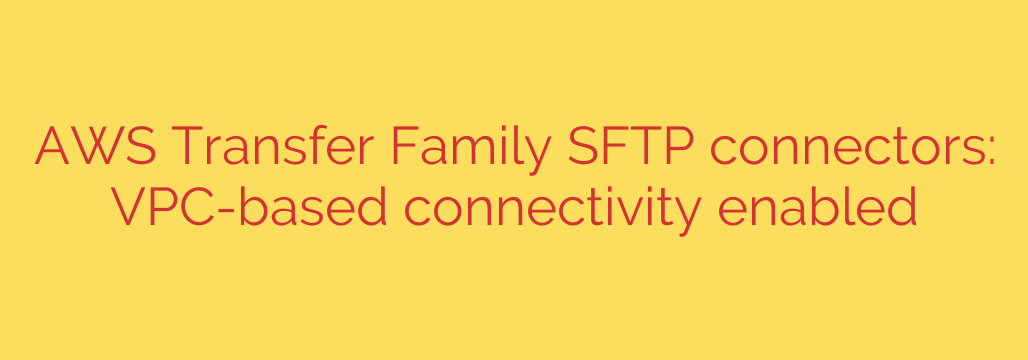
Enhancing Data Security: Connecting to Private SFTP Servers with AWS Transfer Family
Managing secure file transfers is a cornerstone of modern IT operations. For businesses handling sensitive data, ensuring that information remains protected and isolated from the public internet is not just a best practice—it’s often a strict compliance requirement. The AWS Transfer Family has long been a powerful tool for managing SFTP, FTPS, and FTP workflows, but a recent enhancement has fundamentally changed the game for security-conscious organizations.
It is now possible to use AWS Transfer Family SFTP connectors to connect directly to SFTP servers hosted within a private Amazon Virtual Private Cloud (VPC). This is a significant evolution from the previous model, which required destination SFTP servers to be accessible over the public internet. By enabling VPC-based connectivity, you can now build fully private, end-to-end file transfer workflows that offer unparalleled security and simplified network architecture.
The Old Challenge: Public-Facing Endpoints
Previously, when using an SFTP connector to send files to a partner or another internal system, the destination server needed a public IP address. This meant configuring Internet Gateways, managing Network Address Translation (NAT) Gateways, and carefully crafting security group rules to expose the server to the internet. While manageable, this approach introduced an inherent security risk by creating a public-facing footprint, which could become a target for malicious actors.
The New Solution: Private Connectivity with VPC Endpoints
This new capability leverages the power of AWS PrivateLink and VPC interface endpoints to establish a secure, private connection between the AWS Transfer Family service and your target SFTP server.
Here’s how it works:
When you configure an SFTP connector, you can now specify the VPC and subnets where your destination SFTP server resides. The Transfer Family service then provisions an elastic network interface (ENI) within your selected subnet. This ENI gets a private IP address from your VPC’s address range, allowing the connector to communicate directly with the SFTP server over the AWS private network.
The result is a file transfer workflow where your sensitive data never traverses the public internet. This is a critical advantage for organizations subject to strict regulatory frameworks like HIPAA, PCI-DSS, and GDPR.
Key Benefits of VPC-Based SFTP Connectors
Adopting this new architecture provides several immediate and impactful advantages for your file transfer operations.
- Drastically Improved Security: By keeping all data traffic within your private VPC, you eliminate the risks associated with public internet exposure. Your SFTP server is no longer a public endpoint, significantly reducing its attack surface and protecting it from external threats.
- Simplified Network Architecture: You can now remove the complexity and cost associated with NAT Gateways, public IP addresses, and complex internet routing rules for your SFTP servers. Your network topology becomes cleaner, more secure, and easier to manage.
- Streamlined Compliance and Auditing: Proving that sensitive data remains within a private, controlled network is crucial for compliance audits. This feature makes it simple to demonstrate adherence to data residency and security policies, as the entire data path is contained within the AWS backbone.
- Seamless Integration: This feature is ideal for a wide range of use cases, from securely ingesting data from business partners who host their SFTP servers on AWS to automating file transfers between different applications running in separate VPCs within your own organization.
Actionable Security Tips for Implementation
Getting started with a VPC-based SFTP connector is straightforward. Here are a few best practices to ensure a secure and effective setup:
- Utilize Security Groups: When configuring the connector, a security group will be created for its network interface. Configure the security group on your destination SFTP server to only allow inbound traffic on port 22 from the connector’s specific security group. This follows the principle of least privilege and ensures only the Transfer Family connector can communicate with your server.
- Prefer Private Keys for Authentication: While password authentication is supported, using SSH private keys for authentication is a more secure method. Store your private keys securely in AWS Secrets Manager and reference the secret’s ARN when creating the connector for a robust and manageable authentication process.
- Use Private DNS: For easier management, configure a private DNS name for your SFTP server using Amazon Route 53 private hosted zones. This allows you to reference your server with a consistent, human-readable name (e.g.,
sftp.internal.yourcompany.com) instead of a changing private IP address. - Leverage IAM for Fine-Grained Access: As always, use AWS Identity and Access Management (IAM) roles and policies to control who can create, manage, and use SFTP connectors. Grant only the minimum permissions necessary to perform required tasks.
By integrating VPC-based connectivity, AWS Transfer Family SFTP connectors have become an even more powerful tool for building secure, compliant, and efficient file transfer solutions. This update empowers you to design fully private data pipelines, reduce network complexity, and strengthen your overall security posture.
Source: https://aws.amazon.com/blogs/aws/aws-transfer-family-sftp-connectors-now-support-vpc-based-connectivity/







